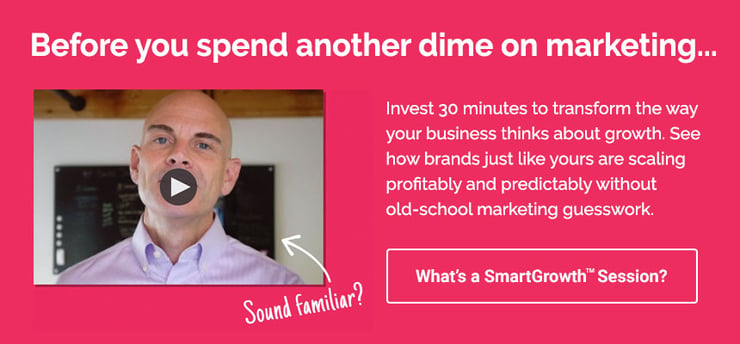In today’s digital marketing landscape, a robust online presence isn't a luxury – it's a lifeline. As B2B leaders, you get it: a powerful website isn't just about showcasing your offerings, it's about resonating with your audience and turning interest into sales. But does your current website measure up? The vast majority of start-up and new B2B websites are what we call “brochure websites” – effectively little more than digital business cards for a brand.
Brochure websites are rarely part of a comprehensive marketing strategy. They often have poor website visitor metrics, little to no SEO, and weak conversion rates. These websites cater only to bottom-of-funnel visitors – those who are already shopping for a solution. But what about all the other potential buyers who are at the top and middle of the funnel? For B2B brands with big growth goals, it’s critical to engage these segments of your market.
In this article, we’ll dive deep into the limitations of brochure websites and explain why a customer-centric website is the golden ticket for B2B brands seeking sustained long-term growth.
Why B2B Brands Need to Ditch Brochure Websites
Although a brochure website can be quickly and inexpensively set up, even in-house, and provide your business with a basic online presence, this style of website is just barely scratching the surface of what a website can and should do to drive visitors, leads, and sales. help attract, nurture, and convert customers.
What’s Wrong with Brochure Websites?
A brochure website may look amazing and showcase your brand beautifully, but if it is all about your brand and your product then your website is only catering to customers at the bottom of the funnel. These customers are already educated and are ready to buy. They are also the smallest percentage of the pool of potential prospects. Catering only to them is leaving money on the table.
Additionally, most brochure-style websites fail to clearly and compellingly differentiate your solution from competitors and alternative options (including doing nothing). If all you do is push your solution without showing customers what makes it different (while poking holes in the competition), customers may simply assume that your solution is largely the same and will default to comparing by price. Show them how it's different. Demonstrate why it’s more effective. Throw rocks at other solutions. The B2B customer journey is long. Customers know they have options. Make their research easier by clarifying what makes you different.
Another problem with brochure websites is that they lack a solid marketing strategy. They are often devoid of SEO. Without a strategy behind the website design, no thought is put into on and off-page SEO best practices, making it that much more unlikely that customers will find the site organically. Leveraging keyword-driven website copywriting [link to 1.2], via blogs and throughout your web pages helps customers at the beginning of the journey to find you. Without SEO content, if a prospect doesn’t already know you exist, the search engines aren’t likely to help them find you.
A lack of strategic design is also apparent when it comes to lead magnets. Brochure websites often feature underwhelming opportunities for visitors to connect with or learn more about the brand. Contact us and email newsletter sign-ups are often buried or given little thought from a customer’s perspective. Lead magnets and other lead generation tactics are a great way to nurture prospects and pull them into the funnel. But you can’t expect customers to want to stay in touch just because your website is pretty. You have to give them a reason. You have to create compelling offers and let them know what they’ll get for sharing their email or booking a meeting.
Finally, a brochure website is usually built on a platform that isn’t equipped for growth. And that’s fine, as long as your website remains nothing more than a digital pamphlet about your product and company. But for B2Bs seeking sustained, long-term growth it’s imperative that their CMS (content management system) be able to be integrated with a CRM so that visitors can be tracked as they engage with content, take specific actions on the website, respond to social posts and eventually, book meetings.
Why a Customer-Centric Website is Best for B2B Brands
1. A Customer-Centric Website Acknowledges Customer Problems
Your B2B exists to solve a problem or help a customer do a job more quickly, more effectively, or more efficiently than before. By acknowledging the problems and challenges your ideal customers face, you become relatable, even trustworthy. You help prospects clarify the challenges they face and discover possible solutions. Starting with the problem rather than the solution is key to giving customers confidence that you understand them. That you ‘get it.’
2. A Customer-Centric Website Addresses Customer Pain Points
What’s a pain point? It’s a hurdle keeping your customer from committing to your solution. It could be a lack of trust or lack of confidence in your product, but it could also be difficulties getting their team on board, budget constraints, or just not having enough information to make a decision. You can build a lot of trust and confidence in prospects by putting yourself in their shoes and imagining what these hurdles might be for them. Then specifically speak to those pain points on your website.
3. A Customer-Centric Website Provides Proof
B2B transactions and relationships are often high-budget and long-term, and customers want to feel confident they are making the right choice for their companies. B2B brands can help prospects alleviate doubts while building authority by incorporating social proof throughout their websites. By offering case studies, statistics, testimonials, and authority badges, brands can demonstrate to clients that their solution is not only effective but used and loved by similar brands in their industry.
4. A Customer-Centric Website Forces Brands to Identify Their Ideal Customer and UVP
Why is this good for B2B? Because clarifying who your ideal customers are helps you speak more authentically and effectively to them. Second, becoming crystal clear on what your UVP (unique value proposition) is, helps you position yourself against competitors and alternative solutions. These two steps enable B2B brands to dial in their messaging to specific audiences and be consistent in how they position themselves across platforms and touch points.
5. A Customer-Centric Website Differentiates You from Your Competition
Customers want to know what makes you different. Why should they choose you? What happens if they don’t? By leaning on your UVP and thinking about customer pain points, you can help customers understand the difference between your approach and how the competition does it. Comparison pages, blog posts, charts, and stats can help bolster your position while providing genuinely useful information to potential customers.
6. A Customer-Centric Website Leverages Effective Lead Magnets
Once upon a time, people would freely give away their email addresses. Not anymore. If you want to stay in touch with the people who are visiting your website you better make it worth their while. Create tools, e-books, calculators, and other valuable, free content that is genuinely helpful to your target audience. Make your newsletter a great industry resource, or a hilarious break from the norm. Create quality lead magnets that offer real benefits to visitors to entice them to share their contact information. Yes, it takes a bit more time and effort, but it’s an effort that will continue working 24/7 once it is live.
7. A Customer-Centric Website Moves Visitors Through the Buyer’s Journey
What is the goal of a customer-centric home page? Initially, to let people know where they are and what you do. But then? The goal is to move them OFF of that page and deeper into the site. Which is to say, it’s job is to pull them into and through the sales funnel. Most B2B websites have lackluster session rates and abysmal return visit rates. Why? Because they aren’t consumer-centric. But, if your website has content that addresses prospects at every stage of the buyer journey, they have a reason to hang around. A reason to come back. And with each page designed to keep them moving along that journey, suddenly your B2B website isn’t just a calling card. It’s a conversion tool.
8. A Customer-Centric Website Is Rooted in Marketing Strategy
Customers can tell when they are being pitched. No one likes to be sold to. A customer-centric website is rooted in demand generation strategy. This strategy draws customers to your site via paid and organic search and through the creation of awesome, helpful content not just on your website but on all channels. It involves freely sharing your expertise (to establish authority), building trust through testimonials and case studies, and essentially projecting confidence in your brand and your solution that positions your company as the single best resource in your industry. Then, when those prospective realize they have a problem, they’ll already be confident you can solve it.
9. A Customer-Centric Website Offers a Virtually Guaranteed ROI (when done right)
Will building a customer-centric website take more time and cost more money than creating a brochure website? Undoubtedly. While designing a robust website that puts the customer at the center of your messaging requires an experienced marketing or web designer to create, and is certainly more expensive than anything you could do in-house the potential for ROI is tremendous. Unlike a brochure website, a strategically designed B2B website can and should be a powerful member of your marketing team – one that never sleeps or takes a vacation. With SEO, lead magnets, and customer-centered messaging working full time, day and night, your website can attract new customers, educate current prospects, help you book meetings, and generate qualified leads 365 days/year.
Final Thoughts on Brochure vs Customer-Centric Websites
For B2B brands, it's clear that a commanding online presence isn't just about having a web address; rather, a B2B website is a strategic tool designed to convert interest into tangible sales and cultivate loyal customers. The difference between a traditional brochure website and a customer-oriented approach can make or break your business's ability to build and sustain meaningful customer relationships.
A brochure website, while easy and cost-effective to create, offers only a rudimentary online presence and often fails to address customer needs and differentiate your brand in the competitive market. However, a customer-centric website, though requiring more investment and expertise, directly addresses customer pain points, offers unique solutions, and provides clear next steps for prospective customers. This type of website can be the strategic move that sets your brand apart, making it a worthwhile investment for B2B companies aiming for sustainable growth.
In the ever-evolving digital marketplace, prioritizing a customer-oriented approach may be the critical factor in securing your business's continued success. It's more than a 'nice-to-have'; it's a roadmap to long-term prosperity in the digital age. At Brand Theory, we build customer-centric B2B websites for brands using a step-by-step approach that helps us to identify your target audience, clarify their problems and pain points, clarify your UVP, and differentiate from competitors. And we do it all in just 12 weeks. To learn more, schedule a no-obligation introduction to Brand Theory today.





.png)
.png)
.png)